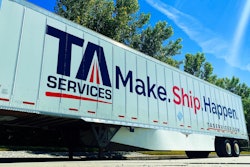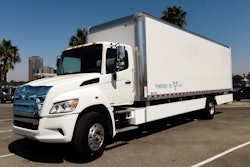The pace of mergers and acquisitions in the trucking world has taken off in the last year or so, but not every married couple goes off to live happily ever after, and sometimes the mere mention of a company being sold is enough to cause an exodus of drivers.
At a recent Workhound webinar, Max Farrell, the company's CEO and co-founder, explained how fleets should execute these sensitive deals both at the negotiating table and within their own organization.
How to talk to drivers about M&A
"Information breeds confidence and silence breeds fear," said Farrell.
Basically, companies need to not only pick the right fit for a firm to partner with or buy, but also how to blend the mix of services and talents, how to maintain consistency with benefits, and then how to communicate these changes to the drivers.
"What we've witnessed is that when mergers or acquisitions occur, workers are often left out of the process. What's been an all-consuming process for executive leaders for months is now suddenly news for the workforce," said Farrell. In the absence of solid information from leadership, drivers tend to "fill in the gaps" with their worst fears, according to Farrell. While a company may be sold because it's doing very well, it often looks to the driver as if the company is going under.
For that reason, fleets should communicate that the acquisition is a good thing, and why and how it came to be.
Also, drivers are going to want to hear from the top what they should expect. In a rumor-dense environment like a merger, having clarity and access to top leadership can make all the difference in drivers' perceptions.
"Having the owner talk about the vision and what his plan is and if they’re becoming part of the future and explaining that this is about honoring the prior brand," means a lot in these situations, Mike McLary, the CEO of Ascend Transport Group said. Owners "definitely" need to pay personal visits to drivers and other key staff, he continued.
"That’s not an option, that’s a must have," he continued. "Getting out there and shaking hands, tell people who you are and that you’re human. Explain the vision and mission."
Even if the new company rebrands, this can actually become an opportunity to better engage with drivers, sometimes in a very simple and effective way.
"Swag is often underestimated," he said. "Drivers love uniforms. Getting them some clean shirts and hats and periodically thanking them works."
When it comes to changes in the company that simply can't be avoided, McLary said if anything, leaders need to over-communicate. Beyond the in-person meetings and corporate talking points, the company should publish a small website that explains the vision and logistics of the merger and refer people back to that.
"Over-prepare and over-deliver," said McLary. "Expect the unexpected and try to put yourself in their position."
How to evaluate company cultures in M&A
What's the biggest mistake fleets often make in the M&A process?
According to Spencer Tenny, the freight M&A specialist who founded The Tenny Group, they "underestimate the degree of how incompatible cultures" can impact the viability of a deal.
Tenny, Farrell, and McLary unanimously agreed that even a great-looking deal on paper can be crushed by. a culture clash within the businesses.
"People tell us all the time, 'Hey me and Johnny down the street are friendly competitors. Let's merge our businesses and go to market so we can get a deal,' but their cultures couldn't be more different," said Tenny. "If you want to lose a lot of money and have a ton of problems, go that route."
So how does an executive evaluate culture fits? Tenny advocates "authentic listening" to drivers and stakeholders. Tenny, and the others on the panel, stressed that executives all tend to have a rosy view of their businesses and cultures, but optimism isn't a solid enough foundation for a successful business.
"The people that have done this really well have gotten input well in advance from the owner" of the fleet to be acquired, said Tenny. He suggested engaging that owner to find out what the personalities within their workforce need in order to feel accepted and that they have buy-in. Plus, keep in mind the current workers already have a relationship with the owner, so honor that.
'"I think if you pay special attention to doing right by the former owner, if that was someone that was admired, that will buy some time to build some respect," he said.
That requires, according to Tenny, listening to mid-management and other longtime staffers who may be the "biggest cheerleaders" of a company culture. By deeply listening to these people, the acquiring company can keep alive what the workers love about their brand.
The panel also stressed the need to have multiple data points in evaluating a company culture by asking open ended questions and then closing the feedback loop with corporate communications that demonstrate lessons learned.













